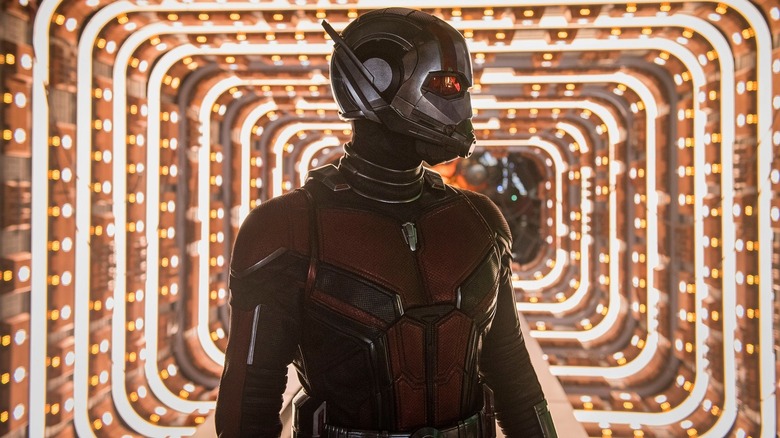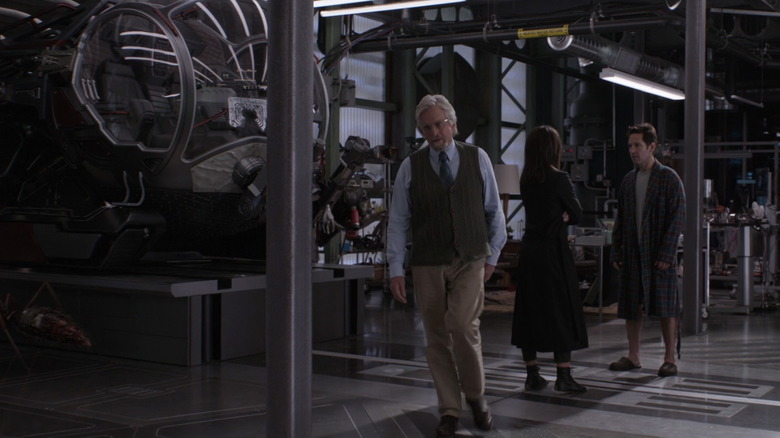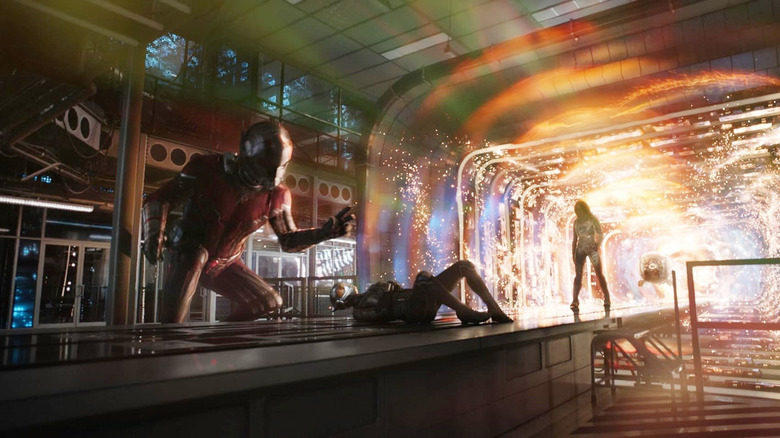Ant-Man And The Wasp's Lab Set Shattered A Massive MCU Record
Peyton Reed's 2018 film "Ant-Man and the Wasp" was released in the wake of "Avengers: Infinity War," one of the major team-up movies that occasionally punctuates the Marvel Cinematic Universe. "Wasp" served, some have said, as a palate cleanser after the major, widely-seen event film, trying to keep the MCU's mood light. This ethos was also employed with Reed's original "Ant-Man" from 2015, which followed "Avengers: Age of Ultron."
"Wasp" took place concurrently with the events of "Infinity War" and was a brisk, comedic heist movie featuring a very human villain played by Walton Goggins. Ant-Man, aka Scott Lang, (Paul Rudd) was under house arrest, which explains why he wasn't present for the big Thanos fight in "Infinity War." The Wasp, aka Hope van Dyne (née Pym), (Evangeline Lilly) and her father Hank (Michael Douglas) have, meanwhile, built a massive, high-tech shrinking tunnel which will serve as an entrance to the Quantum Realm, a miniature dimension much smaller than the smallest subatomic particles. Hank's beloved wife Janet (Michelle Pfeiffer) accidentally shrank herself into the Quantum Realm years before, and now Hank wants to rescue her.
The plot of the film involves the black market purchase of a rare machine part that Hank requires to build his Quantum Tunnel, as well as a mysterious ghost-like villain who can pass through walls.
Uncharacteristically for the MCU, the Quantum Tunnel was a hand-constructed, outsize practical set, coated with metal panels and glowing tubes. It was large enough for multiple actors to walk inside of. It was also located entirely in Hank's particle physics laboratory, a massive research enclave that contained multiple offices, testing rooms, and a while helicopter. According to Reed's audio commentary for "Wasp" (available on Disney+), the lab was the largest practical set ever built for an MCU film.
Meet Ant-Man and the Wasp production designer Shepherd Frankel
It has seemingly been an enforced mandate that MCU films be made with as much expensive (and rushed) CGI as possible. The Marvel universe is, after all, a fantastical place full of super-powered robots, psychics, wizards, and reality-controlling magic stones. It stands to reason that extensive VFX would be required to realize it in live-action. Many of the filmmakers in the MCU, however, might have taken their use of VFX a little too far, sometimes using CGI backgrounds or animated characters when practical makeup or sets might have looked better. Reed, wanting his film to look a little more tactile than its peers, had a massive set built, allowing the actors to explore a physical space organically:
"They have created this entirely new laboratory in which Hope and Hank are working on this amazing quantum tunnel. The quantum tunnel, I should do a shout-out here to Shepherd Frankel, our production designer. This is the largest physical set that's ever been built for a Marvel movie. It's a little counterintuitive that 'Ant-Man and The Wasp' has the largest physical set."
It was insightful of Reed to notice the irony.
Shepherd Frankel began working as a production designer on commercials in the early 2000s and landed his first film gig with "Step Up" in 2006. He subsequently worked on several high-profile Hollywood comedies, establishing himself as a reliable and talented showbiz presence. His first Marvel project was the 2012 short film "Item 47," which took place in the aftermath of "The Avengers." He also designed the Marvel shorts "Agent Carter" and "All Hail the King" before being hired by Reed for the first "Ant-Man." Frankel's other work includes the elaborate designs for "Uncharted," as well as the upcoming "Harold and the Purple Crayon."
Peyton Reed wanted the real world to feel real in Ant-Man and the Wasp
Reed rightfully pointed out that the fantasy of the MCU doesn't stand out unless it can be juxtaposed against something real. "I fought really hard to have Hank's lab be a real tactile functioning set," he explained in a making-of featurette, also available on Disney+. "There are digital extensions, but the set is this massive set that we built. And it's important because the real world has to look and feel like the real world." Digital extensions are, as the term implies, a way to make an existing set look a little bigger with SFX embellishments. Even without those embellishments, though, the set was huge.
Frankel also appears in the featurette and he briefly gave his design ethos for Hank's lab:
"When we walk in here, the idea is to feel a really crushed horizontal space with a reflective ceiling. We wanted this moment of walking into the lab to be really dramatic. And we wanted our audience to have a very distinct change of scale. [...] The main event inside the space is the Quantum Gate. Peyton was really interested in honoring and referencing traditional time tunnels, but taking it to a whole other level."
It should be noted that Hank's lab, while a massive, shiny, high-tech workspace, was located secretly inside a seemingly dilapidated building. The exterior was not impressive, so the inside had to counterbalance that.
As for "traditional time tunnels," Frankel is referring to the one-season 1966 sci-fi series "The Time Tunnel," wherein a pair of scientists enter a high-tech, tunnel-shaped time machine and become lost in history. It's nice to know that Peyton Reed is versed in the classics.


